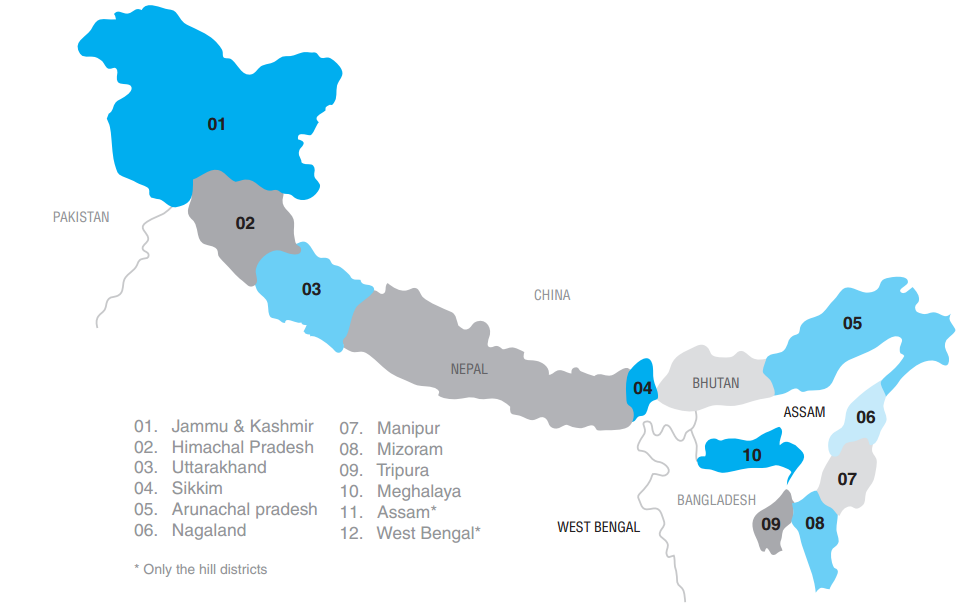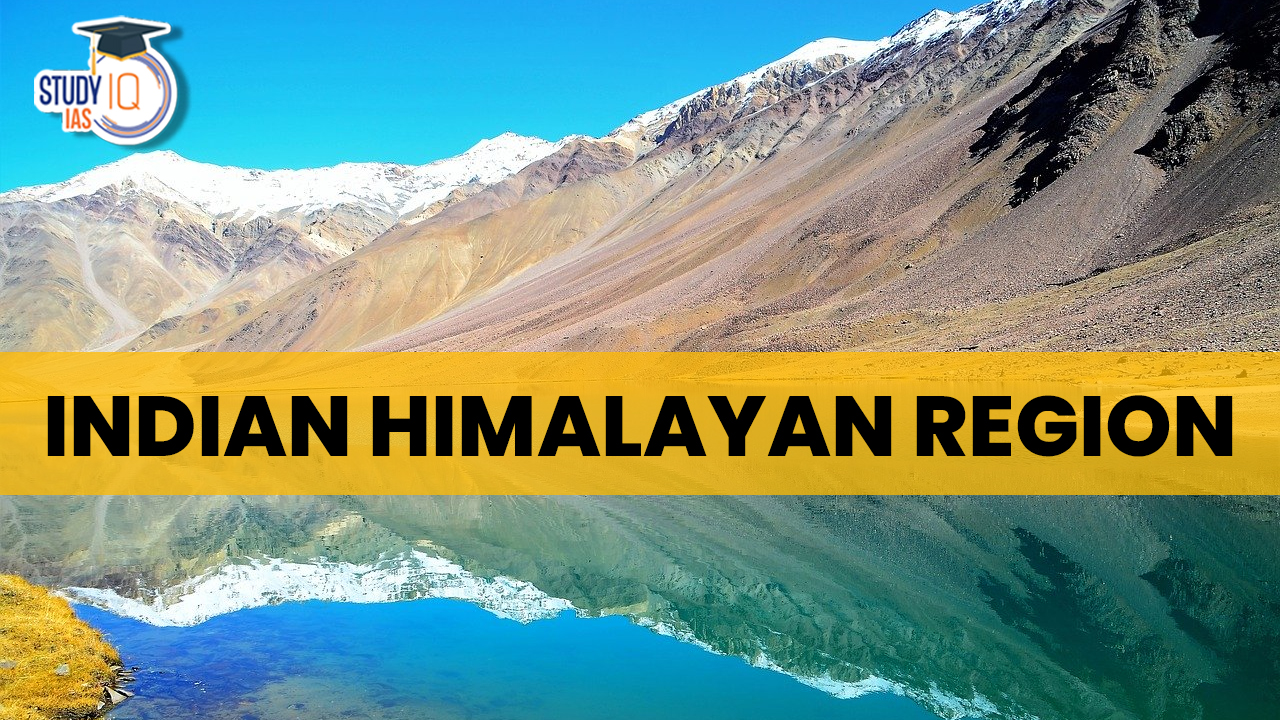Table of Contents
Indian Himalayan Region (IHR) in News
The Centre has proposed forming a 13-member technical committee to evaluate the “carrying capacity” of 13 Himalayan States in the Indian Himalayan Region (IHR).
- The carrying capacity of an area can be defined as the “maximum number of populations that can be supported by the environment of that area through optimum utilization of the available resources”.
- Need for evaluating carrying capacity in the Indian Himalayan Region (IHR):
- Natural Disasters and Safety: Frequent landslides, flash floods, and other natural disasters have led to loss of lives and destruction in these states. This led the Supreme Court to moot a re-evaluation of the load-carrying capacity of hill towns and cities.
- Environmental Sustainability: Hill stations and ecologically sensitive areas in the IHR are popular tourist destinations. Ensuring that tourism activities align with the carrying capacity of the environment is essential for long-term environmental sustainability.
- Urban Planning: Many hill towns and cities lack comprehensive master plans that consider carrying capacity and environmental factors.
- In March 2021, the National Green Tribunal had directed all state governments to undertake carrying capacity studies of ecologically sensitive areas.
About the Indian Himalayan Region (IHR)
- The Indian Himalayan Region (IHR) is the section of the Himalayas within India, spanning thirteen Indian States and Union Territories namely Ladakh, Jammu and Kashmir, Himachal Pradesh, Uttarakhand, Sikkim, West Bengal, Manipur, Meghalaya, Mizoram, Nagaland, Tripura, Assam, and Arunachal Pradesh.
- Vast Area: IHR has a geographical coverage of over 5.3 lakh kilometer square, extends over 2,500 kilometers in length between the Indus and the Brahmaputra River systems.
- Physiography: The IHR physiographically, starting from the foothills in the south (Siwaliks), extends up to the Tibetan plateau in the north (Trans-Himalaya).
- The region can be categorized into three major geographical entities:
- Himadri (Greater Himalaya): The highest and most rugged part of the Himalayas, characterized by snow-capped peaks and glaciers.
- Himanchal (Lesser Himalaya): Located south of the Himadri, this region is less rugged and features a range of hills and valleys.
- Siwaliks (Outer Himalaya): The southernmost part of the Himalayas, consisting of foothills and low-lying terrain.
- The region can be categorized into three major geographical entities:

Significance of IHR
- Biodiversity Hotspot: The IHR is a biodiversity hotspot, home to a wide variety of flora and fauna, including many endangered species.
- Water Source: The region is the source of several major rivers, including the Ganga, Yamuna, Brahmaputra, and their tributaries.
- Cultural and Religious Significance: The Himalayas hold deep cultural and religious significance in India. Many sacred sites, temples, and monasteries are located in the region.
- Tourism: The Himalayas are a major tourist destination, drawing visitors from around the world for trekking, mountaineering, and adventure sports.
- Hydropower Generation: The steep terrain and abundant rivers in the Himalayas make it an ideal location for hydropower generation.
Almost 33% of the country’s thermal electricity and 52% of its hydropower are dependent on river waters originating in the Himalayas.
- Ecological Services: The IHR provides essential ecological services such as carbon sequestration, soil conservation, and maintenance of microclimates.
Major Challenges in the IHR
- Town Planning Issues: Rapid and unplanned growth of hill towns and cities, often without proper urban planning, has resulted in chaotic urban development.
- Noncompliance with environmental norms and guidelines has exacerbated the challenges faced by the Himalayas.
- Environmental Degradation: Haphazard urbanization has led to the degradation of the fragile Himalayan ecosystem.
- Deforestation, construction activities, and indiscriminate land use have disrupted the natural balance, leading to soil erosion, loss of biodiversity, and other environmental problems.
- Unsustainable Tourism: Unsustainable tourism practices, such as overexploitation of natural resources and disturbance to the unique flora and fauna, pose significant risks to the region’s ecology and biodiversity.
- Solid Waste Management: The influx of residents, tourists, trekkers, and mountaineers has resulted in a substantial increase in solid waste generation.
- Inadequate waste management infrastructure has led to the indiscriminate dumping of solid waste, further polluting the region.
- Climate Change: The Himalayas are highly vulnerable to climate change, with rising temperatures causing the melting of glaciers and the formation of glacial lakes.
- This increases the risk of glacial lake outburst floods, which can have devastating consequences for downstream communities.
- Some 8,800 glacial lakes in the Himalayas are spread across nations, and more than 200 of these have been classified as dangerous.
- IHR is also facing increased frequency and duration of extreme weather events and natural hazards.
- Faulty Infrastructure Projects: While hydroelectric projects are essential for renewable energy and revenue generation, poorly planned and constructed projects can exacerbate the impact of natural disasters like floods.
Government Initiatives for the IHR
- The National Mission for Sustaining the Himalayan Ecosystem (NMSHE): It is one of the eight missions under the National Action Plan on Climate Change (NAPCC).
- NMSHE seeks to facilitate policy measures and time-bound action programmes to sustain ecological resilience and ecosystem services in the Himalayas.
- Indian Himalayas Climate Adaptation Programme (IHCAP): It aims to enhance the resilience of vulnerable communities in the Indian Himalayas through strengthening the capacities of Indian institutions in climate science as well as institutional capacities of Himalayan states in India on adaptation planning, implementation and policy.
Way Forward
- Sustainable Tourism: Mechanisms for sustainable tourism growth with minimal biodiversity impact and sustainable livelihood options for locals should be developed.
- The transition toward ecotourism should be carefully promoted, emphasizing best practices and knowledge dissemination.
- Sustainable Infrastructure Projects: Town planning and building designs in the Himalayan region should align with the local ecosystem, seismic considerations, and aesthetic principles.
- Environmental Impact Assessment (EIA): The proper EIA process should be followed when approving new infrastructure or tourism projects in the region.
- Pan-Himalayan Strategy: Collaboration among Himalayan states is essential to develop common policies and prevent a “race to the bottom” in terms of development.
- Race to the bottom approach is when the government deregulates the business environment in order to attract or retain economic activity in a region.
- International Collaboration: Himalayan countries should establish an international network to monitor risks such as those associated with glacial lakes.
- Early warning systems, similar to those used for tsunamis in the Indian Ocean, can help mitigate natural hazards.


 Places in News for UPSC 2026 for Prelims...
Places in News for UPSC 2026 for Prelims...
 Lake Natron: Location, Features, Wildlif...
Lake Natron: Location, Features, Wildlif...
 Erra Matti Dibbalu Added to UNESCO Tenta...
Erra Matti Dibbalu Added to UNESCO Tenta...

























